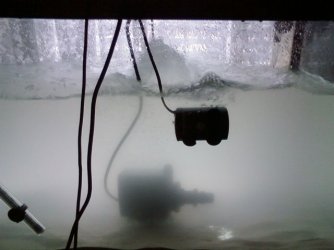So i finally got around to starting my first marine tank and have been doing extensive research for months about it. So naturally the one area i didn't even think to research on causes me trouble =(
Basically i picked up some salt mix (instant ocean) yesterday, had some previously made up de-chlorinated water (tap water, water stats are pretty good in my area) and mixed the salt into the water. The result was a very cloudy mixture =/
Now the lady at the the LFS did warn me that there would be some cloudiness and it should pass in a day so i waited overnight and checked again in the morning and it's still damn cloudy. So i hopped onto google and tried to find out some info. Apparently alot of other people have had this issue, some of them say it passed and was fine after, others say they chucked it all out and started again, others say it some kind of calcium precipitation? So i should increase water flow, so i'm now just waiting with a massive powerhead (and two smaller ones) chugging water around and hoping whatever it is dissolves properly.
So what do you guys think? What exactly is it? Have you had this problem before?
Also yes I'm sure it's not the sand. My annoying brother chucked it in without my consent *glares*
and a picture is attached... taken with a phone camera so please excuse the quality
Basically i picked up some salt mix (instant ocean) yesterday, had some previously made up de-chlorinated water (tap water, water stats are pretty good in my area) and mixed the salt into the water. The result was a very cloudy mixture =/
Now the lady at the the LFS did warn me that there would be some cloudiness and it should pass in a day so i waited overnight and checked again in the morning and it's still damn cloudy. So i hopped onto google and tried to find out some info. Apparently alot of other people have had this issue, some of them say it passed and was fine after, others say they chucked it all out and started again, others say it some kind of calcium precipitation? So i should increase water flow, so i'm now just waiting with a massive powerhead (and two smaller ones) chugging water around and hoping whatever it is dissolves properly.
So what do you guys think? What exactly is it? Have you had this problem before?
Also yes I'm sure it's not the sand. My annoying brother chucked it in without my consent *glares*
and a picture is attached... taken with a phone camera so please excuse the quality



